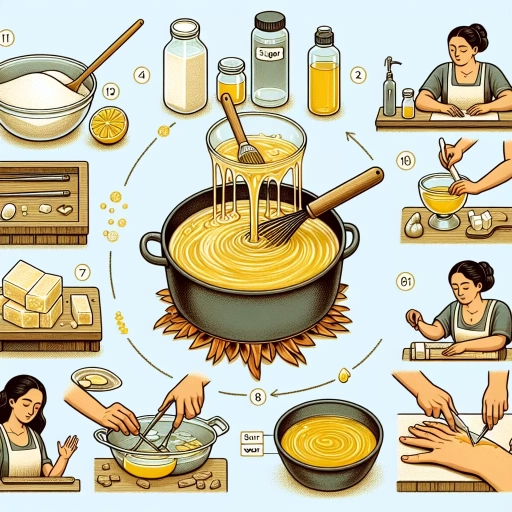How To Make Sugar Wax

Understanding the Basics of Sugar Waxing
What is Sugar Waxing?
Sugar waxing, also known as sugaring, is an ancient hair removal method that has been used in Middle Eastern countries for centuries. It is a natural and less painful alternative to traditional waxing and is gaining popularity in Western countries due to its numerous benefits. The wax is made from basic kitchen ingredients—sugar, water, and lemon juice, which are cooked together until they reach a candy-like consistency. When applied to the skin and ripped off, the sugar wax removes hair from the root, ensuring smooth and hair-free skin.
The Benefits of Sugar Waxing
Unlike traditional waxing, sugar waxing is a safer and healthier alternative because it uses all-natural, hypoallergenic ingredients. This means it's a good option for those with sensitive skin. Furthermore, sugaring removes hair from the root, which means that results can last up to six weeks. Additionally, the process of sugaring can lead to hair growing back softer, thinner, and sparser, which makes subsequent hair removal easier and less painful. Finally, because the sugar wax only sticks to the hair, not the skin, it causes less discomfort and irritation than traditional waxing methods.
How to Prepare Your Skin for Sugar Waxing
Before you start with the sugar waxing process, it is essential to prepare your skin properly to ensure its effectiveness and prevent any possible skin irritation. Start by cleaning and exfoliating your skin to get rid of any oil, dirt, and dead skin cells. This will allow the sugar wax to adhere better to the hair. You should also go for a patch test to ensure that your skin doesn't react negatively to the sugar wax. Moreover, your hair should be at least 1/4 inch long for the wax to grip it effectively, but it shouldn't be too long, or it might break during the waxing process.
Creating Your Own Sugar Wax
Sugar Wax Ingredients and Tools
Sugar waxing uses simple, all-natural ingredients that are likely already in your pantry. All you need is a cup of granulated sugar, two tablespoons of lemon juice, and two tablespoons of water. Additionally, you will need a medium-sized pot to cook the mixture, a spatula or wooden spoon to stir, and a heat-proof container to store the wax. Some clean strips of cloth and a spatula to spread the wax will also be needed during the application.
The Cooking Process
Begin by combining all the ingredients in the pot and stirring them over medium heat until the sugar completely dissolves. Once the sugar has dissolved, lower the heat and let the mixture simmer. Keep stirring at an interval until the mixture turns a dark amber color. This might take about 20-30 minutes. After getting the right color and consistency, remove the pot from the heat and let it cool for a moment before transferring to the storage container. Allow the wax to cool down before using it. Make sure it's warm but not hot to prevent any skin burns.
Wax Application Technique
Once your sugar wax has cooled down to a safe, comfortable temperature, it's time to apply it to the skin. Use the spatula or wooden applicator to spread a thin layer of the sugar wax on the area you want to wax, making sure to follow the direction of the hair growth. After application, place a cloth strip over the waxed skin and press down firmly. After a few seconds, quickly rip off the strip in the opposite direction of hair growth. Repeat the process until all unwanted hair is removed. Remember to moisturize your skin after the waxing process to soothe and hydrate it.
Maintaining Results and Aftercare
Aftercare Tips
The immediate period following a sugar waxing session is crucial in terms of aftercare. The skin is usually sensitive and needs extra attention. Avoid activities that could cause sweat or dirt to irritate the freshly waxed skin, such as working out or swimming. Make sure to gently cleanse and exfoliate the waxed areas after 24 hours, and regularly moisturize to keep the skin soft and prevent ingrown hairs. Also, avoid sun exposure as much as possible to protect the freshly waxed skin.
Maintaining the Results
To maintain the smooth results, a schedule for regular sugar waxing every four to six weeks is recommended. This varies among individuals and depends on the rate at which your hair grows back. Continuous waxing will ensure the hair will grow back thinner and sparser over time, making each subsequent waxing session easier and less painful. You should also exfoliate in between waxing to keep the skin smooth and clear of dead skin cells, and prevent the development of ingrown hairs.
Addressing Common Sugar Waxing Problems
Like any other waxing method, sugar waxing can sometimes cause minor issues like redness, irritation, or ingrown hairs. Applying a cold compress can ease redness and inflammation, while ingrown hairs can be prevented by regularly exfoliating the skin to keep the hair follicles clear. If you experience consistent skin irritation, it might be best to see a dermatologist or professional waxing technician. Lastly, practice makes perfect when it comes to sugar waxing at home, and the results will improve each time.